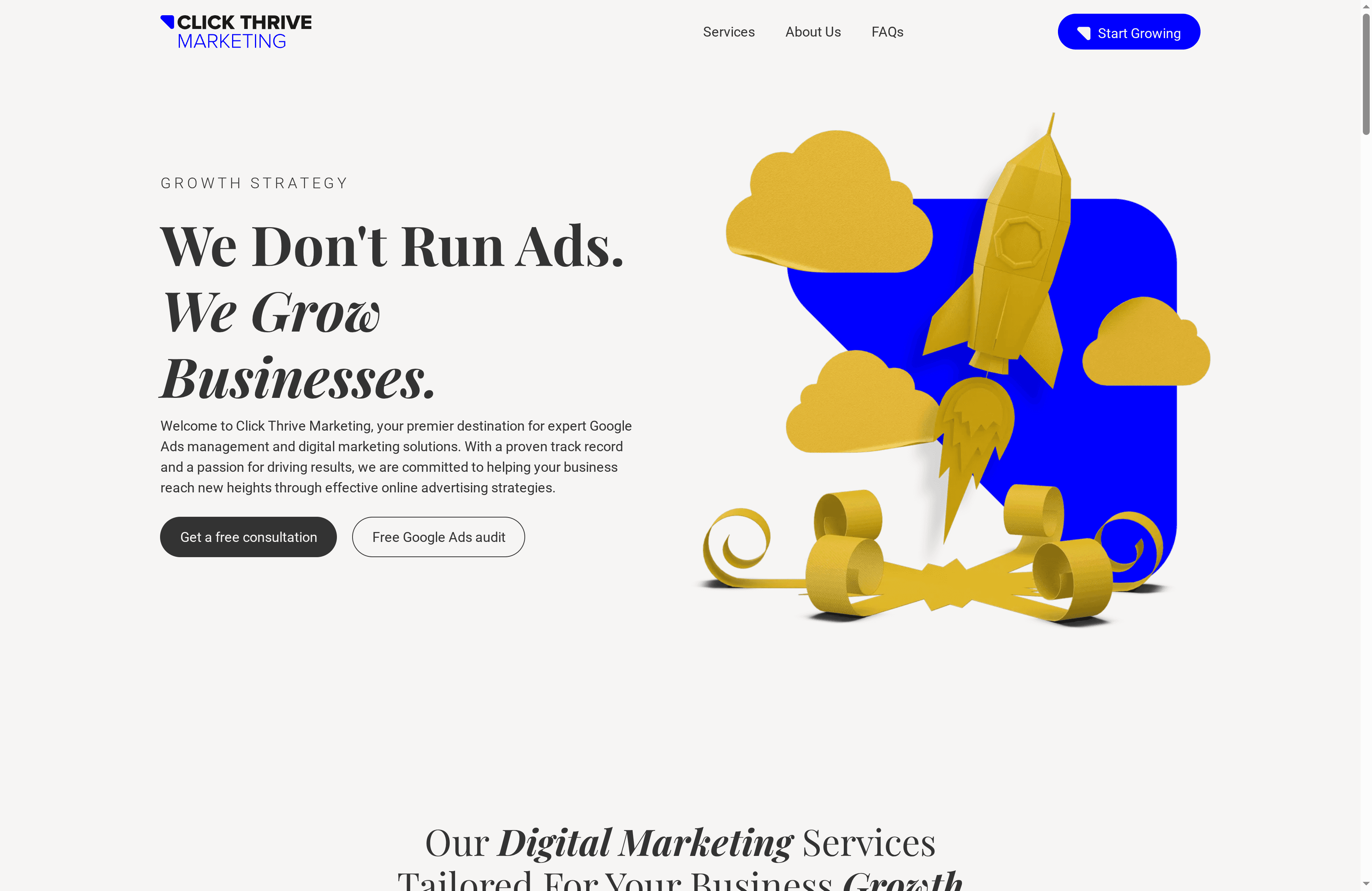Over half of small businesses fail to grow past their fifth year, yet many of these setbacks trace back to missed opportunities in developing clear strategies for expansion. With market shifts happening faster than ever, understanding growth strategies is not just useful, it shapes the survival of every company. This guide breaks down actionable approaches that help organizations compete, adapt, and thrive in any business climate.
Table of Contents
- Defining Business Growth Strategies Today
- Types Of Growth Strategies For SMBs
- Digital Marketing’s Role In Business Growth
- Key Factors For Sustainable Expansion
- Common Pitfalls And Best Practices
Key Takeaways
| Point | Details |
|---|---|
| Strategic Growth Planning | Businesses must define intentional growth strategies to expand market presence and ensure competitiveness in uncertain times. |
| Diverse Growth Strategies for SMBs | Small businesses can leverage market penetration, product expansion, and strategic partnerships to achieve sustainable growth. |
| Role of Digital Marketing | Engaging in digital marketing and analytics is essential for attracting and retaining customers in today’s market landscape. |
| Avoiding Common Pitfalls | Companies should be proactive in maintaining customer loyalty and ensuring flexibility in their operations to prevent stagnation and resource misallocation. |
Defining Business Growth Strategies Today
In the dynamic world of business, growth strategies represent intentional plans organizations develop to expand their market presence, increase revenue, and create sustainable competitive advantages. According to Columbia Business School, defining a growth strategy becomes particularly critical during uncertain economic periods, emphasizing the need for businesses to adapt and innovate continuously.
Small businesses and entrepreneurs have multiple pathways to achieve strategic growth. The Better Business Bureau highlights several fundamental approaches businesses can leverage:
- Market Penetration: Increasing market share within existing markets
- Customer Loyalty Programs: Developing retention strategies to maintain and expand current customer base
- Strategic Partnerships: Collaborating with complementary businesses to expand reach
Successful growth strategies require comprehensive analysis of internal capabilities and external market conditions. Business leaders must continuously assess their competitive landscape, understand customer needs, and remain agile enough to pivot when necessary. Performance marketing techniques can help organizations track and optimize their strategic initiatives, ensuring measurable progress towards expansion goals.
Types Of Growth Strategies For SMBs
Small and medium-sized businesses (SMBs) have multiple strategic pathways to expand their operations and increase market presence. The Better Business Bureau outlines several fundamental growth strategies that can help businesses achieve sustainable expansion:
- Market Penetration: Increasing market share within existing markets
- Market Development: Exploring new market segments or geographical areas
- Product Expansion: Developing new products or services
- Strategic Partnerships: Collaborating with complementary businesses
The Strategy Institute expands on these approaches, recommending advanced strategies like joint ventures, digital transformation, and mergers and acquisitions. When considering growth, SMBs must conduct thorough market research and assess their internal capabilities to determine the most appropriate strategy.
Specifically, digital transformation offers significant opportunities for SMBs to scale their operations. Google Ads best practices can help businesses leverage online platforms to reach new customer segments and drive strategic growth. By combining multiple growth strategies and maintaining a customer-centric approach, small businesses can create robust expansion plans that adapt to changing market conditions and capitalize on emerging opportunities.
Digital Marketing’s Role In Business Growth
Digital marketing has transformed how small and medium businesses approach growth, providing unprecedented opportunities to reach and engage potential customers. The Greensboro Chamber of Commerce emphasizes the critical importance of elevating social media presence and leveraging analytics to effectively connect with target audiences.
Key digital marketing strategies for business growth include:
- Social Media Engagement: Building meaningful online connections
- Targeted Advertising: Reaching specific customer segments
- Content Marketing: Creating valuable, relevant content
- Performance Analytics: Measuring and optimizing marketing efforts
The Hartford highlights the significance of personalized marketing and customer loyalty programs as essential components of digital growth strategies. By implementing a comprehensive digital marketing guide, businesses can create data-driven campaigns that not only attract new customers but also retain existing ones. The ability to track, measure, and quickly adapt marketing strategies provides SMBs with a competitive edge in today’s rapidly evolving digital landscape.
Key Factors For Sustainable Expansion
Sustainable business expansion requires a strategic and comprehensive approach that goes beyond simple growth tactics. Oregon State University emphasizes the critical importance of setting SMART goals – Specific, Measurable, Achievable, Relevant, and Time-bound – as a fundamental framework for driving meaningful business growth.
Key factors for sustainable expansion include:
- Strategic Planning: Developing clear, actionable roadmaps
- Brand Development: Creating a strong, distinctive market identity
- Financial Management: Maintaining robust cash flow and investment strategies
- Continuous Learning: Adapting to market changes and emerging technologies
The Rhode Island Small Business Development Center recommends conducting comprehensive SWOT analyses (Strengths, Weaknesses, Opportunities, Threats) to align business strategy with organizational structure. Conversion rate optimization techniques can provide crucial insights into refining business models and ensuring long-term sustainability. By maintaining flexibility, investing in continuous improvement, and staying attuned to market dynamics, businesses can create a resilient foundation for sustained growth and competitive advantage.
Common Pitfalls And Best Practices
Business growth is a complex journey fraught with potential challenges and opportunities. The Better Business Bureau highlights critical pitfalls that can derail business expansion, emphasizing the importance of proactive strategy and continuous adaptation.
Common pitfalls businesses must navigate include:
- Customer Loyalty Neglect: Failing to maintain existing customer relationships
- Market Rigidity: Resisting necessary changes and innovations
- Scalability Limitations: Inability to efficiently grow operational capabilities
- Resource Misallocation: Ineffective investment of time and capital
The National Business Association recommends strategic approaches to mitigate these risks, such as leveraging public speaking opportunities and creating strategic partnerships. By implementing Google Ads best practices, businesses can amplify their brand presence and create more targeted growth strategies. Successful expansion requires a delicate balance of innovation, adaptability, and strategic planning, ensuring that businesses can overcome challenges while maintaining sustainable growth trajectories.
Unlock Your Business Growth Potential with Proven Digital Marketing Solutions
Business growth strategies can feel overwhelming when you face challenges like market rigidity, customer loyalty neglect, or resource misallocation. This article highlights critical pain points such as the importance of strategic partnerships, performance analytics, and conversion rate optimization to create sustainable expansion. If you want to move beyond theory and start seeing measurable results, leveraging professional Google Ads management and lead generation is key.
Take control of your growth journey today by partnering with Click Thrive Marketing. Our expert team specializes in optimizing digital campaigns that maximize ROI and attract high-quality leads for small to medium-sized businesses. Visit our Uncategorized Archives – Click Thrive Marketing to explore insights that complement your current strategies. Don’t wait to boost your competitive advantage. Discover tailored solutions at Click Thrive Marketing and transform your business growth plans into real success.
Frequently Asked Questions
What are the key types of growth strategies for small and medium-sized businesses?
Small and medium-sized businesses can utilize several growth strategies including market penetration, market development, product expansion, and strategic partnerships to enhance their market presence and revenues.
How does digital marketing contribute to business growth?
Digital marketing enhances business growth by allowing companies to engage with potential customers through social media, targeted advertising, content marketing, and performance analytics, enabling them to reach specific audiences effectively.
What factors should businesses consider for sustainable expansion?
Key factors for sustainable expansion include strategic planning, brand development, financial management, and continuous learning to adapt to market changes and maintain growth.
What common pitfalls should businesses avoid when seeking growth?
Businesses should be wary of neglecting customer loyalty, resisting necessary market changes, facing scalability limitations, and misallocating resources, as these pitfalls can hinder effective growth strategies.








